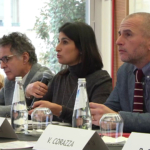The Paris summit Cop21 climate finished and delegates feverishly worked to find a final agreement that does not result in a mere declaration of intent. China was heavily involved in the debate, since it was suspended between the requirements of industrial development and the need to cut emissions and greenhouse gases, for the good of the planet and of its own citizens.
[subscriptionform]
[level-european-affairs]
China, despite some slowing, is still growing at a fast pace and feeds its industrial development with a high consumption of coal and other polluting fuels. December 2nd, at the Paris summit, Beijing has announced its plans to cut the main pollutant emissions over 4 years. By 2020 they will be cut by 60% and, at the same time, it should be a reduction, for industry, of 180 million tons of CO2 each year. It remains to understand what China means by “major pollutants” and if, among them, will be considered greenhouse gases.
Beyond the skepticism expressed by some, it seems that Beijing wants to redesign its growth model, reducing the use of coal and betting on forms of clean and renewable energy. The environmental issue is not only about the near future of the country. Even the present is heavily involved, because air pollution has reached alarming levels both in Beijing and in other major cities in China. Earlier this week, in the capital has been proclaimed the red alert, after that smog levels far in excess of the permitted range have been recorded, with harmful consequences for the health of citizens.
The emergency measures, which included the closure of schools and construction sites and a sharp reduction in private circulation, have proved effective, and the sun has returned to make its appearance in the skies long obscured of the megalopolis. The red alert now ceased, but the problem was just postponed. The warning pollution does not afflict only Beijing. In the big cities of northern China the authorities did not adopt measures whatsoever and tens of millions of people continue to breathe extremely toxic air, with values of harmfulness even higher than those that led to the paralysis of the capital.
As reported by The New York Times, in Anyang, Henan Province, the air quality index showed a value of 999, three times higher than that registered in Beijing earlier this week. In the city of Handan, Hebei Province, it has been slightly better, with the indicator stopped at 822. For instance, a value of 300, the United States, is already considered dangerous to human health. Much of the pollution that grips Beijing is not produced from the drainpipes of cars, but comes from the north where, to meet industrial needs, are burned every day huge quantities of coal.
The central government and the provincial governments are therefore called upon to take prompt action to protect the health of their citizens, requiring the adoption of emergency procedures standardized in all regions of the country, involving also construction sites and factories. Once past the emergency, it will be necessaire to quickly understand how to balance the demands of industrial development which led China’s GDP to exceed the American one, with the imperatives of public health, in China and elsewhere. The commitments announced by the Chinese delegation to the climate conference in Paris seem a step in the right direction, but the claims will have to be followed by concrete action. In a very short time.
Luca Marchesini
[/level-european-affairs]








[…] Not much, compared to the values recorded in the capital and in the northern cities last week, but still enough to encourage the local authorities to declare a “yellow alert” and […]